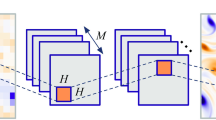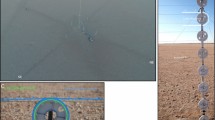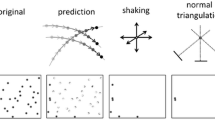Abstract
In this paper, the problem of improving the quality of low-resolution passive scalar image sequences is addressed. This situation, known as “image super-resolution” in computer vision, aroused to our knowledge very few applications in the field of fluid visualization. Yet, in most image acquisition devices, the spatial resolution of the acquired data is limited by the sensor physical properties, while users often require higher-resolution images for further processing and analysis of the system of interest. The originality of the approach presented in this paper is to link the image super-resolution process together with the large eddy simulation framework in order to derive a complete super-resolution technique. We first start by defining two categories of fine-scale components we aim to reconstruct. Then, using a deconvolution procedure as well as data assimilation tools, we show how to partially recover some of these missing components within the low-resolution images while ensuring the temporal consistency of the solution. This method is evaluated using both synthetic and real image data. Finally, we demonstrate how the produced high-resolution images can improve a posteriori analysis such as motion field estimation.
















Similar content being viewed by others
Notes
Written in vector form.
This category of methods relies on a single LR image in order to produce a HR output, whereas a lot of super-resolution methods require several LR images of the same scene.
AAE between two velocity fields \(\mathbf {v}\) and \(\mathbf {v} ^*\) reads \(AAE(\mathbf {v} )= arcos(\frac{\mathbf {v} \cdot \mathbf {v} ^*}{\Vert \mathbf {v} \Vert \cdot \Vert \mathbf {v} ^* \Vert }).\)
References
Baker S, Kanade T (2002) Limits on super-resolution and how to break them? IEEE Trans Pattern Anal Mach Intell 24(9):1167–1183
Bennett AF (1992) Inverse methods in physical oceanography. Cambridge monographs on mechanics and applied mathematics. Cambridge University Press, Cambridge, New York
Borman S, Stevenson RL (1998) Super-resolution from image sequences—a review. In: Proceedings of the 1998 midwest symposium on circuits and systems
Bruhn A, Weickert J, Schnörr C (2005) Lucas/kanade meets horn/schunck: combining local and global optic flow methods. Int J Comput Vis 61(3):211–231
Cassisa C, Simoens S, Prinet V, Shao L (2011) Subgrid scale formulation of optical flow for the study of turbulent flow. Exp Fluids 51(6):1739–1754
Chen X, Zillé P, Shao L, Corpetti T (2015) Optical flow for incompressible turbulence motion estimation. Exp Fluids 56(1):1–14
Corpetti T, Memin E, Perez P (2002) Dense estimation of fluid flows. IEEE Trans Pattern Anal Mach Intell 24(3):365–380
Corpetti T, Mémin E, Pérez P (2003) Extraction of singular points from dense motion fields: an analytic approach. J Math Imaging Vis 19(3):175–198
Farsiu S, Robinson MD, Elad M, Milanfarv P (2004) Fast and robust multiframe super-resolution. IEEE Trans Image Process 13:1327–1344
Gronskis A, Heitz D, Mémin É (2013) Inflow and initial conditions for direct numerical simulation based on adjoint data assimilation. J Comput Phys 242:480–497. doi:10.1016/j.jcp.2013.01.051
Hardie RC, Barnard KJ, Armstrong EA (1997) Joint map registration and high-resolution image estimation using a sequence of undersampled images. IEEE Trans Image Process 6:1621–1633
Héas P, Mémin E, Heitz D, Mininni P (2012) Power laws and inverse motion modeling: application to turbulence measurements from satellite images. Dyn Meteorol Oceanogr 64:10962. doi:10.3402/tellusa.v64i0.10962
Heitz D, Mémin E, Schnörr C (2010) Variational fluid flow measurements from image sequences: synopsis and perspectives. Exp Fluids 48(3):369–393. doi:10.1007/s00348-009-0778-3
Horn B, Schunck B (1981) Determining optical flow. Artif Intell 17(173):185–203
Jullien M-C, Castiglione P, Tabeling P (2001) Intermittency of a passive tracer in the inverse energy cascade. Phys Rev E 64(3):035301. doi:10.1103/PhysRevE.64.035301
Keane R, Adrian R (1992) Theory of cross-correlation analysis of piv images. Appl Sci Res 49(3):191–215
Kim K, Kwon Y (2010) Single-image super-resolution using sparse regression and natural image prior. IEEE Trans Pattern Anal Mach Intell 32(6):1127–1133
Kurganov A, Tadmor E (2000) New high-resolution central schemes for nonlinear conservation laws and convection? diffusion equations. J Comput Phys 160(1):241–282
Le Dimet F-X, Talagrand O (1986) Variational algorithms for analysis and assimilation of meteorological observations: theoretical aspects. Tellus 38A:97–110
Lions J (1971) Optimal control of systems governed by PDEs. Springer, NewYork
Lucas BD, Kanade T (1981) An iterative image registration technique with an application to stereo vision. IJCAI 81:674–679
Moin P, Squires K, Cabot W, Lee S (1991) A dynamic subgrid-scale model for compressible turbulence and scalar transport. Phys Fluids 3(11):2746–2757
Nasrollahi K, Moeslund T (2014) Super-resolution: a comprehensive survey. Mach Vis Appl 25(6):1423–1468
Papadakis N, Corpetti T, Mémin E (2007) Dynamically consistent optical flow estimation. In: IEEE 11th international conference on computer vision (ICCV’07). Rio de Janeiro, Brazil, pp 1–7. doi:10.1109/ICCV.2007.4408889
Park SC, Park MK, Kang MG (2003) Super-resolution image reconstruction: a technical overview. IEEE Signal Process Mag 20(3):21–36. doi:10.1109/msp.2003.1203207
Peleg T, Elad M (2014) A statistical prediction model based on sparse representations for single image super-resolution. Image Process IEEE Trans 23(6):2569–2582
Purkait P, Chanda B (2012) Super resolution image reconstruction through Bregman iteration using morphologic regularization. Image Process IEEE Trans 21(9):4029–4039
Rabaud V, Belongie S (2005) Big little icons. CVPR 3:24–30
Sagaut P (2006a) Large eddy simulation for incompressible flows. Springer edition
Sagaut P (2006b) Multiscale and multiresolution approaches in turbulence. Imperial College Press, London
Su LK, Dahm WJA (1996a) Scalar imaging velocimetry measurements of the velocity gradient tensor field in turbulent flows. I. Assessment of errors. In: Proceedings of imaging understanding workshop
Su LK, Dahm WJA (1996b) Scalar imaging velocimetry measurements of the velocity gradient tensor field in turbulent flows. II. Experimental results. Phys Fluids 8(7):1883–1906
Sun D, Roth S, Darmstadt T (2010) Secrets of optical flow estimation and their principles. In: Proceedings of 2010 IEEE computer vision and pattern recognition, pp 2432–2439
Sun J, Xu Z, Shum H-Y (2008) Image super-resolution using gradient profile prior. In: CVPR. IEEE Computer Society. ISBN 978-1-4244-2242-5. http://dblp.uni-trier.de/db/conf/cvpr/cvpr2008.html#SunXS08
Talagrand O, Courtier P (1987) Variational assimilation of meteorological observations with the adjoint vorticity equation I: theory. Q J R Meteorol Soc 113(478):1311–1328
Vidard P, Blayo E, Le Dimet F-X, Piacentini A (2000) 4d variational data analysis with imperfect model. Flow Turbul Combust 65(3–4):489–504
Wen S, Yan L, Feng W, Shipeng L (2009) Real-time screen image scaling and its GPU acceleration. In: ICIP. IEEE, pp 3285–3288. ISBN 978-1-4244-5654-3. http://dblp.uni-trier.de/db/conf/icip/icip2009.html#SunLWL09a
Yang J, Wright J, Huang T, Ma Y (2010) Image super-resolution via sparse representation. Image Process IEEE Trans 19(11):2861–2873
Zhou F, Yang W, Liao Q (2012) Interpolation-based image super-resolution using multisurface fitting. IEEE Trans Image Process 21(7):3312–3318
Zille P, Corpetti T, Shao L, Chen X (2014) Observation model based on scale interactions for optical flow estimation. Image Process IEEE Trans 23(8):3281–3293
Acknowledgments
This work is supported by CaiYuanPei EGIDE grant.
Author information
Authors and Affiliations
Corresponding author
Appendices
Appendix 1: Introduction to 4DVAR algorithm
In this section, we provide a few details about variational data assimilation techniques, and more specifically the 4DVAR algorithm. For a complete methodological review of these techniques as well as applications dedicated to geophysical flow, we refer to Bennett (1992), Dimet and Talagrand (1986), Lions (1971), Vidard et al. (2000), Talagrand and Courtier (1987).
Let us assume we aim at estimating a state variable X partially known and driven by an approximately known dynamical law. In other words, we want to estimate values \(X(\mathbf {x} ,t)\) for any location \(\mathbf {x}\) and time \(t \in [t_0,t_f]\) solution of the following system:
where \({\mathbb {M}}\) is the nonlinear operator relative to the dynamics, \(X_0\) is the initial vector at time \(t_0\) and \((\nu _{d},\nu _{o},\nu _{i})\) are (unknown) additive control variables relative to noise on the dynamics and the initial condition respectively. In addition, noisy measurements Y of the unknown state are available through the nonlinear operator \({\mathbb {H}}\) up to \(\nu _{o}\). To estimate the system’s state, a common methodology is the minimization of the cost function \({\mathcal {J}}\) :
where we have introduced the information matrices R, B, Q relative to the covariance of the errors \((\nu _{d},\nu _{o},\nu _{i})\). The Mahalanobis distance that has been used reads \(\Vert X \Vert _{A^{-1}} = X^TA^{-1}X\). The evaluation of X can be done by canceling the gradient \(\nabla {\mathcal {J}}_X(\theta ) = lim_{\beta \rightarrow 0} \frac{{\mathcal {J}}(X + \beta \theta ) - {\mathcal {J}}(X)}{\beta }\) of (16). Unfortunately, the estimation of such gradient is in practice unfeasible for a large system’s state since it would be necessary to compute perturbations along all the components of X. One way to cope with this difficulty is to write an adjoint formulation of the problem. To that end, the adjoint variables \(\lambda\) that express the errors of the dynamic model are introduced as:
Let us now introduce a few notations
-
\(\frac{\partial {\mathbb {M}}}{\partial X}\) and \(\frac{\partial {\mathbb {H}}}{\partial X}\) the linear tangent operators of M and H, respectively,
-
\((\partial _X{\mathbb {M}})^*\) and \((\partial _X{\mathbb {H}})^*\) their adjoint operators.
It can be shown that canceling the gradient \(\nabla {\mathcal {J}}_X(\theta )\) w.r.t the adjoint variables \(\lambda\) leads to a retrograde integration of an adjoint evolution model that takes into account the observations. Once the adjoint variables \(\lambda\) are estimated, one can recover the system state X using relation (17). Finally, recovering X leads to the following incremental algorithm:

Intuitively, the adjoint variables \(\lambda\) contain information about the discrepancy between the observations and the dynamic model. They are computed from a current solution \(\tilde{X}\) with the backward integration from step (ii) that encompasses both the observations and the dynamic operators. This deviation indicator between the observations and the model is then used to refine the initial condition [step (iii) and to recover the system state through an imperfect dynamic model where errors are \(Q\lambda\) (step (iv)]. It should be noted that if the dynamic is perfect, the associated error covariance Q is zero and the algorithm only refines the initial condition. However from an image analysis point of view, a perfect modeling is difficult to obtain since the different models on which one can rely are usually inaccurate due, for instance, to 3D–2D projections, varying lighting conditions, completely unknown boundary conditions at the image boarders, etc.
Appendix 2: Motion estimation from a pair of images
Many possibilities are available to estimate a motion field from a pair of images. Among main strategies [correlation Keane and Adrian (1992), Lucas and Kanade (1981)] or Horn and Schunck Horn (1981), we rely in this paper on the seminal work of Horn and Schunck which aims at estimating a velocity field \(\mathbf {v}\) on the image domain \(\varOmega\) by the minimization of the function :
where \(I(\mathbf {x} ,t)\) is the brightness intensity function in location \(\mathbf {x}\) at time t(viewed as a continuous function). This functional is composed of an observation model (here the total derivative that assumes a global conservation of \(I\) along time: \({\rm d}I/{\rm d}t \sim 0\)) and a regularization term which aims at estimating velocity fields with low spatial variation of u and v components. Parameter \(\alpha\) is balancing the relative influence of the observation model and the smoothing term.
Many authors have proposed alternatives (multi-resolution, optimization with various norms, ...) on the basis of Eq. (18) to design advanced models. In this paper we use the technique proposed in Chen et al. (2015) which is a combination of approaches in Cassisa et al. (2011), Corpetti et al. (2002) and aims at optimizing an observation term issued from a turbulence model for resolved scales associated with a regularization that minimizes the divergence of the flow. The model reads (with \((\bullet ) = (\mathbf {x} ,t)\)):
All implementations details are visible in Chen et al. (2015). It should be noted that several authors have proposed motion estimation techniques for fluid flows. We refer the readers to Bruhn et al. (2005), Cassisa et al. (2011), Corpetti et al. (2002), Héas et al. (2012), Zille et al. (2014) or to the review paper Heitz et al. (2010).
Rights and permissions
About this article
Cite this article
Zille, P., Corpetti, T., Shao, L. et al. Super-resolution of turbulent passive scalar images using data assimilation. Exp Fluids 57, 21 (2016). https://doi.org/10.1007/s00348-015-2104-6
Received:
Revised:
Accepted:
Published:
DOI: https://doi.org/10.1007/s00348-015-2104-6




